Development of Oil-Free Lubricants for Cold Rolling of Low-Carbon Steel †
Abstract
1. Introduction
2. Most Relevant Results from the ROF Project
- -
- Tribological tests:
- The Mini Traction Machine (MTM) was used to determine a Stribeck curve by varying the speed between 0 and 4 m/s at a fixed temperature of 80 °C and a fixed load of 40 N (i.e., corresponding to typical pressures during cold rolling).
- The SRV-tester (German abbreviation for Oscillation, Friction and Wear) was used to determine the load-carrying capacity of the lubricant by increasing the load on a 10 mm diameter ball until failure occurs. The tests were carried out at 55 °C at an oscillation frequency of 50 Hz.
- A Ball-on-Disc machine was used at a load of 2 to 10 N, a speed of 0.1 m/s and a temperature of 45 °C to evaluate the ‘dynamic friction behaviour’ (i.e., stick-slip).
- -
- Corrosion tests, foaming tests and ageing tests were conducted to evaluate the steel surface protection and the stability of the OFL.
- -
- Compatibility tests of the OFL with bearings, gaskets and sealings were conducted.
- -
- The risks of implementing water-based lubricants in industrial rolling practice were further decreased by investigating their influence on the subsequent production steps.
- -
- Furthermore, lubricant maintenance and care technologies were developed.
3. ROF-II Project
3.1. Organisation of ROF-II Project
3.2. Experimental Equipment Used in the ROF-II Project
4. Pilot Mill Trials
- -
- For automotive rolling, the reference lubricant consists mostly of synthetic and natural esters, furthermore antioxidants, EP/AW additives and friction modifiers are added. Furthermore, emulsifiers are added to form a stable 2% O/W emulsion. This lubricant was compared to a recirculating 15% solution of OFL in (demineralised) water. The resulting lubricant was applied both at the entry and exit of the mill at a flow-rate of, respectively, 250 L/min and 150 L/min. The work roll diameter was 400 mm, ground to an initial Ra value of 0.8 µm, which is a typical value for an industrial sheet mill.
- -
- For tinplate rolling, the reference lubricant is entirely different than is is for automotive rolling, and it consists of palm oil with some additives. This lubricant has no emulsifying properties, and a MIDAS was used to apply the lubricant (18% oil in water). This lubricant was compared to a 15% solution of OFL in water. The total flow-rate through the MIDAS was 6 L/min. In this case, the recirculating system was filled with water and was used to cool the process (both at the exit and entry).
4.1. Pilot Mill Results: Coefficient of Friction
- -
- The rolling force;
- -
- The forward slip (defined as , where is the exit speed of the strip and is the roll speed);
- -
- The rolling torque.
- -
- The 2nd reference with O/W emulsion shows a lower forward slip than the 1st reference (thus, friction is lower for the 2nd reference). This is expected because the work rolls have slightly worn off during the trial. However, the difference between the 1st and 2nd reference is rather small compared to the differences between the different lubricants, showing that the work roll wear does not dominate. The differences between the various lubricants can therefore be attributed to the lubricant itself (and not the work roll wear).
- -
- Up to high rolling speeds (the 3rd and 4th pass were carried out at 10 m/s resp. 11 m/s), the OFLs perform reasonably well.
- -
- For the automotive grades, OFL1 results in similar (but slightly higher) COF than the reference emulsion. In contrast, OFL2 and OFL3 result in lower COF than the reference emulsion.
- -
- For the tinplate grade, it was impossible to complete pass five of the rolling schedule with the OFLs in the recirculating system. With an extra-high concentration of OFL3 in the MIDAS, it was possible to roll the 5th pass, but only at an adapted rolling speed and with a very low thickness reduction of 6% (therefore, this datapoint is not shown in Figure 8). Only with the conventional reference lubricant was it possible to roll the 5th pass at the foreseen rolling speed and at the desired thickness reduction of 35%. With the OFLs, work roll kissing apparently occurred in the 5th pass. The rolling force was very high, while the thickness reduction remained relatively low. In contrast, in passes 1–4, the OFLs performed equally as well as the reference product. This must be investigated further to determine whether or not this is a particularity of the oil-based lubricant; furthermore, the experimental results should be duplicated in a subsequent pilot mill trial.
- -
- The conclusions above show that to discern between different lubricants, rolling processes with thin material can best be used (which is in agreement with the rolling theory [45]). It seems as if the rolling of very thin material is a critical test for OFLs, and this finding should be incorporated in the trial program for any future OFL developments.
4.2. Pilot Mill Results: Strip Cleanliness
4.3. Pilot Mill Trial: Miscellaneous Results
- (1)
- The strip temperature was measured before and after each rolling pass. Only for OFL1 was the strip temperature before pass one lower than the cloud-point. The strip temperature before the other passes and after each pass was higher than the cloud-point for all of the OFLs.There was no clear relation between the measured strip temperature and the performance of the OFLs (or the conventional lubricants).
- (2)
- For OFL1, there was important mist formation in each pass, despite the available air suction system at the pilot mill. The degree of mist formation would not be acceptable in industrial cold rolling.
- (3)
- A magnetic filter was installed to examine the uptake of iron fines by an OFL solution. Furthermore, a monitoring device for OFL was installed during the pilot mill trial, which measured the conductivity, pH, temperature, refractive index and turbidity of the solution. The conclusions from this analytic device will be separately reported.
5. Summary and Outlook
- -
- All three OFLs result in very good strip cleanliness (quantified by the reflection tape value).
- -
- In the automotive steel rolling trials, OFL2 and OFL3 result in lower COF than the emulsion for the reference sheet mill (Thyssenkrupp Bruckhausen), while OFL1 performs slightly worse than this reference.
- -
- In the tinplate steel rolling trials, OFL2 and 3 perform equally as well in the first passes, but in the last pass with the thinnest material, the reference (oil-based) product performs better. Again, OFL1 performs slightly worse than the reference.
Author Contributions
Funding
Data Availability Statement
Acknowledgments
Conflicts of Interest
References
- Diegelmann, V.; Ostrowski, J.; Folland, C.; Raulf, M.; Batista, C.; Charbonnier, P.; Speer, M.; Johnson, A.; Saffer, T.; Mintken, S. Application of Single-Phase Oil-Free-Lubricants in Cold and Hot Rolling of Flat Material. In Tribology—Industrial and Automotive Lubrication; Technische Akademie Esslingen: Esslingen, Germany, 2020. [Google Scholar]
- Chakraborty, S.; Giri, S.S.; Pandit, A.; Bhagat, A.; Jha, A.K. Kinetics study of cold rolling lubricant degradation through advanced instrumental techniques. Lubr. Sci. 2022, 35, 171–182. [Google Scholar] [CrossRef]
- Cassarini, S. Modélisation du Film Lubrifiant dans la Zone D’entrée, pour la Lubrification par Emulsion en Laminage à Froid. Ph.D. Thesis, École Nationale Supérieure des Mines de Paris, Paris, France, 2007. (In French). [Google Scholar]
- Schey, J.A. Tribology in Metalworking Friction, Lubrication and Wear; American Society for Metals: Metals Park, OH, USA, 1983; ISBN 0871701553. [Google Scholar]
- Wilson, W.R.D.; Walowit, J.A. An Isothermal Hydrodynamic Lubrication Theory for Strip Rolling with Front and Back Tension. In Tribology Convention; Institution Mechanical Engineers: London, UK, 1971; pp. 164–172. [Google Scholar]
- Lévêque, R.; de Werbier, P.; Biausser, H.; Fromholz, C. Lubrication as an element of cold rolling process. Rev. Métallurgie 1991, 88, 849–860. [Google Scholar] [CrossRef]
- Hiver, P. Synthese et Etude D’additifs Bifonctionnels Extreme-Pression et Tensioactifs pour Lubrifiants. Ph.D. Thesis, Université Paul Verlaine-Metz, Metz, France, 1995. (In French). [Google Scholar]
- Reich, R.; Wise, J.; Colbert, R. The Effectiveness of Boundary and Hydrodynamic Lubrication when Cold Rolling Aluminum Metal. Tribol. Trans. 2008, 51, 627–635. [Google Scholar] [CrossRef]
- Kimura, Y.; Fujita, N.; Matsubara, Y.; Kobayashi, K.; Amanuma, Y.; Yoshioka, O.; Sodani, Y. High-speed rolling by hybrid-lubrication system in tandem cold rolling mills. J. Mater. Process. Technol. 2015, 216, 357–368. [Google Scholar] [CrossRef]
- Tak Takakusaki, T.; Iwasaki, M.; Fukuyama, S.; Misonoh, K. Development of Rolling Oil for High Speed Cold Strip Rolling. Trans. Iron Steel Inst. Jpn. 1982, 22, 233–241. [Google Scholar] [CrossRef]
- Meulders, J.B.A.F. Coolant Demands for Silicon Steel Rolling. In Proceedings of the AISTech Conference 2023, Detroit, MI, USA, 8–11 May 2023. [Google Scholar]
- Chakraborty, S.; Giri, S.S.; Pandit, A.; Bhagat, A.N.; Prakash, R.; Jha, A.K. Effect of Ageing of Rolling Oil on the Performance of Cold-Rolled Steel. Lubr. Sci. 2023, 36, 457–467. [Google Scholar] [CrossRef]
- Dong, H.; Zhang, Y.; Hu, W.; Ba, Z.; Zhang, Y. Design and Engineering Application of Direct Mixing Lubrication System for Emulsion Pipeline in Secondary Cold Rolling Mill. Mech. Eng. Sci. 2020, 2, 36–47. [Google Scholar] [CrossRef]
- Jacobs, L.; Verhoeven, R.; Drent, P.; op ’t Roodt, J.; van Eijk, E.; Story, P. Flexible Lubrication Trial on Double Cold Reduction Mill No. 11 of Tata Steel. In Proceedings of the 12th International ROLLING Conference, Trieste, Italy, 26–28 October 2022. [Google Scholar]
- Lo, S.-W.; Yang, T.-C.; Lin, H.-S. The lubricity of oil-in-water emulsion in cold strip rolling process under mixed lubrication. Tribol. Int. 2013, 66, 125–133. [Google Scholar] [CrossRef]
- Lee, R.-T.; Yang, K.-T.; Chiou, Y.-C. Mixture Lubrication with Emulsions in Cold Rolling. Tribol. Trans. 2016, 59, 748–757. [Google Scholar] [CrossRef]
- Der, O.; Bertola, V. An experimental investigation of oil-water flow in serpentine channel. Int. J. Multiph. Flow 2020, 129, 103327. [Google Scholar] [CrossRef]
- Kovalev, A.; Yagodnitsyna, A.; Bisky, A. Plug flow of immiscible liquids with low viscosity ratio in serpentine microchannels. Chem. Eng. J. 2021, 417, 127933. [Google Scholar] [CrossRef]
- Ma, L.; Ma, X.; Bai, S.; Zhou, C.; Jiang, Z.; Wang, T.; Zhao, J. Research progress of nanolubrication for rolling process. Int. J. Adv. Manuf. Technol. 2023, 129, 999–1015. [Google Scholar] [CrossRef]
- Ma, L.; Ma, L.; Lian, J.; Wang, C.; Ma, X.; Zhao, J. Tribological Behavior and Cold-Rolling Lubrication Performance of Water-Based Nanolubricants with Varying Concentrations of Nano-TiO2 Additives. Lubricants 2024, 12, 361. [Google Scholar] [CrossRef]
- Antonicelli, M.; Liuzzo, U.; Palumbo, G. Evaluation of the Effect of a Natural-Based Emulsion on the Cold Rolling Process. J. Manuf. Mater. Process. 2023, 7, 121. [Google Scholar] [CrossRef]
- Gryglewicz, S.; Piechocki, W.; Gryglewicz, G. Preparation of polyol esters based on vegetable and animal fats. Bioresour. Technol. 2003, 87, 35–39. [Google Scholar] [CrossRef]
- Guglielmi, P.; Davoodi, F.; Palumbo, G.; Carbone, G. Tribological behaviour of microindented 100Cr6 steel surfaces in dry contact conditions. Int. J. Adv. Manuf. Technol. 2024, 133, 2381–2400. [Google Scholar] [CrossRef]
- Sato, T.; Besshi, T.; Sato, D.; Tsutsui, I. Effect of water based lubricants on wear of coated material. Wear 2001, 249, 50–55. [Google Scholar] [CrossRef]
- Fan, M.; Du, X.; Ma, L.; Wen, P.; Zhang, S.; Dong, R.; Sun, W.; Yang, D.; Zhou, F.; Liu, W. In situ preparation of multifunctional additives in water. Tribol. Int. 2019, 130, 317–323. [Google Scholar] [CrossRef]
- Liu, Z.; Xue, W.; Shi, J.; Han, S.; Yan, J. Recent advances in polyalkylene glycol base oil. Res. Chem. Intermed. 2024, 50, 1515–1539. [Google Scholar] [CrossRef]
- Greaves, M.R. PolyAlkylene Glycols: Present and future applications. Tribol. Lubr. Technol. 2013, 69, 34–39. [Google Scholar]
- N Sagraloff, N.; Dobler, A.; Tobie, T.; Stahl, K.; Ostrowski, J. Development of an Oil Free Water-Based Lubricant for Gear Applications. Lubricants 2019, 7, 33. [Google Scholar] [CrossRef]
- Rudnick, L.R. Lubricant Additives: Chemistry and Application, 3rd ed.; CRC Press: Portland, OR, USA, 2017. [Google Scholar]
- Basten, S.; Kirsch, B.; Hasse, H.; Aurich, J.C. Formulation of sub-zero metalworking fluids for cutting processes: Influence of additives. J. Manuf. Sci. Technol. 2020, 31, 25–33. [Google Scholar] [CrossRef]
- Lenard, J.G. (Ed.) Metal Forming Science and Practice; Elsevier Science: Amsterdam, The Netherlands, 2002. [Google Scholar]
- Tahir, M. Some Aspects on Lubrication and Roll Wear in Rolling Mills. Ph.D. Thesis, KTH Royal Institute of Technology, Stockholm, Sweden, 2003. [Google Scholar]
- Johnsson, A.; Ekman, M.; Janols, A. Developing environmentally friendly rolling lubricants. J. Eng. Tribol. 2011, 225, 932–939. [Google Scholar] [CrossRef]
- Diegelmann, V.; Raulf, M.; Charbonnier, P.; Batista, C.; Speer, M.; Nitzsche, G.; Johnson, A.; Sidestam, P.; Folland, C.; Ostrowski, J.; et al. Steel Cold Rolling with Aqueous Oil-Free Lubricants, Final Report RFCS (Grant Agreement 709504). Available online: https://www.bfi.de/en/projects/rolloilfree-steel-cold-rolling-with-aqueous-oilfree-lubricants/ (accessed on 14 April 2025).
- Helmetag, K. Predictive Testing of Steel Rolling Oils Using the Elastohydrodynamic Lubrication Rig. Tribol. Trans. 2005, 48, 119–126. [Google Scholar] [CrossRef]
- Smeulders, B. Novel Laboratory Lubrication Tests for Cold Rolling Emulsions. Iron Steel Technol. 2015, 12, 56–64. [Google Scholar]
- Gonçalves, J.L., Jr.; Biasoli de Mello, J.D.; Costa, H.L. Wear in cold rolling milling rolls: A methodological approach. Wear 2019, 426–427, 1523–1535. [Google Scholar] [CrossRef]
- Jianlin, S.; Xinming, Z. Evaluation of Lubricants for Cold Rolling Aluminum Strips. J. Cent. South Univ. Technol. 1997, 4, 65–68. [Google Scholar] [CrossRef]
- van Steden, H.; Neumann, W.; Suilen, F.; Bos, S.; Schoone, E. Pilot mill as the key to optimize lubrication and strip cleanliness. In Proceedings of the 7th International Conference on Steel Rolling, Chiba, Japan, 9–11 November 1998; pp. 467–472. [Google Scholar]
- Rolland, S.; Tacik, F.; Laugier, M.; Masson, P. Changement d’huile et optimization du process des émulsions recirculées du train tôles minces de Ste Agathe. Metall. Res. Technol. 2004, 101, 731–778. [Google Scholar]
- Lin, J.F.; Huang, T.K.; Hsu, C.T. Evaluation of lubricants for cold strip rolling. Wear 1991, 147, 79–91. [Google Scholar] [CrossRef]
- Colla, V. Comprehensive Overview of the ROF-II Project, Deliverable D1.1. 2024. Available online: https://www.rolloilfree2.eu/public-deliverables/ (accessed on 14 April 2025).
- Bakermans, P.; Smeulders, B.; Jacobs, L. Oil Free Lubricants for the Steel Cold Rolling Process. In Proceedings of the AISTech 2025, Nashville, TN, USA, 5–8 May 2025. [Google Scholar]
- Yuen, W.Y.D.; Popelianski, Y.; Prouten, M. Variations of Friction in the Roll Bite and their Effects on Cold Strip Rolling. Iron Steelmak. 1996, 23, 33–39. [Google Scholar]
- Von Karman, T. Beitrag zur Theorie des Walzvorganges. Z. Angew. Math. Mechanik 1925, 5, 139–141. [Google Scholar] [CrossRef]
- Krauth, P.J. Contrôle de la propreté des surfaces d’aciers. Rev. De Métallurgie 2002, 99, 561–568. (In French) [Google Scholar] [CrossRef]
- Fisher, T.W.; Lezzi, R.A.; Madritch, J.M. Theoretical and practical considerations of sheet steel surface cleanliness. SAE Trans. 1980, 89, 923–935. [Google Scholar]
- Klare, A.; Krietemeier, T.; Brüne, B.; Conradt, S. Increased Product Range and Cost Reduction by Modern Cold Rolling Emulsion. In Proceedings of the 6th European Rolling Conference & 9th International Rolling Conference, Venice, Italy, 10–12 June 2013. [Google Scholar]

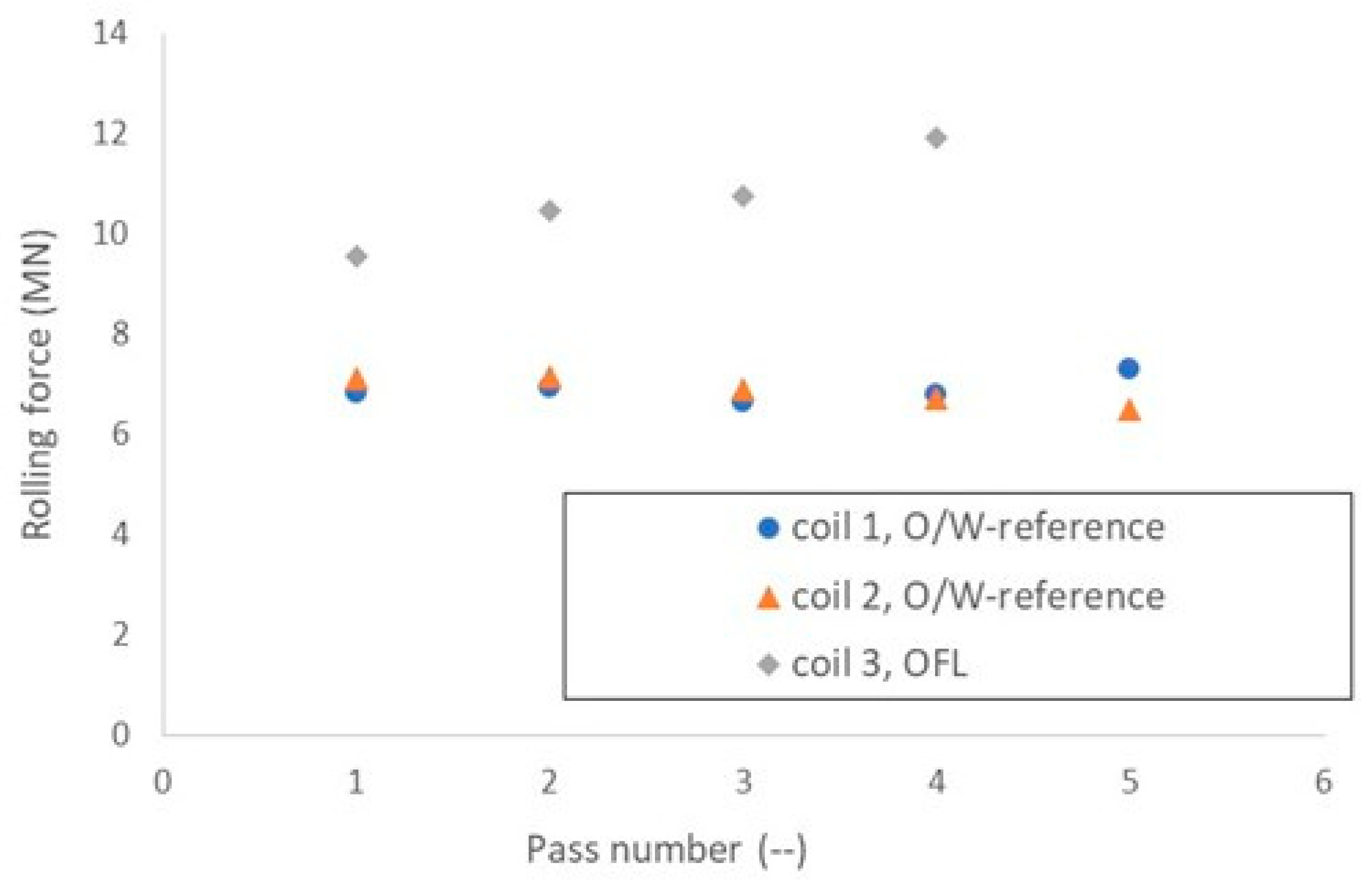
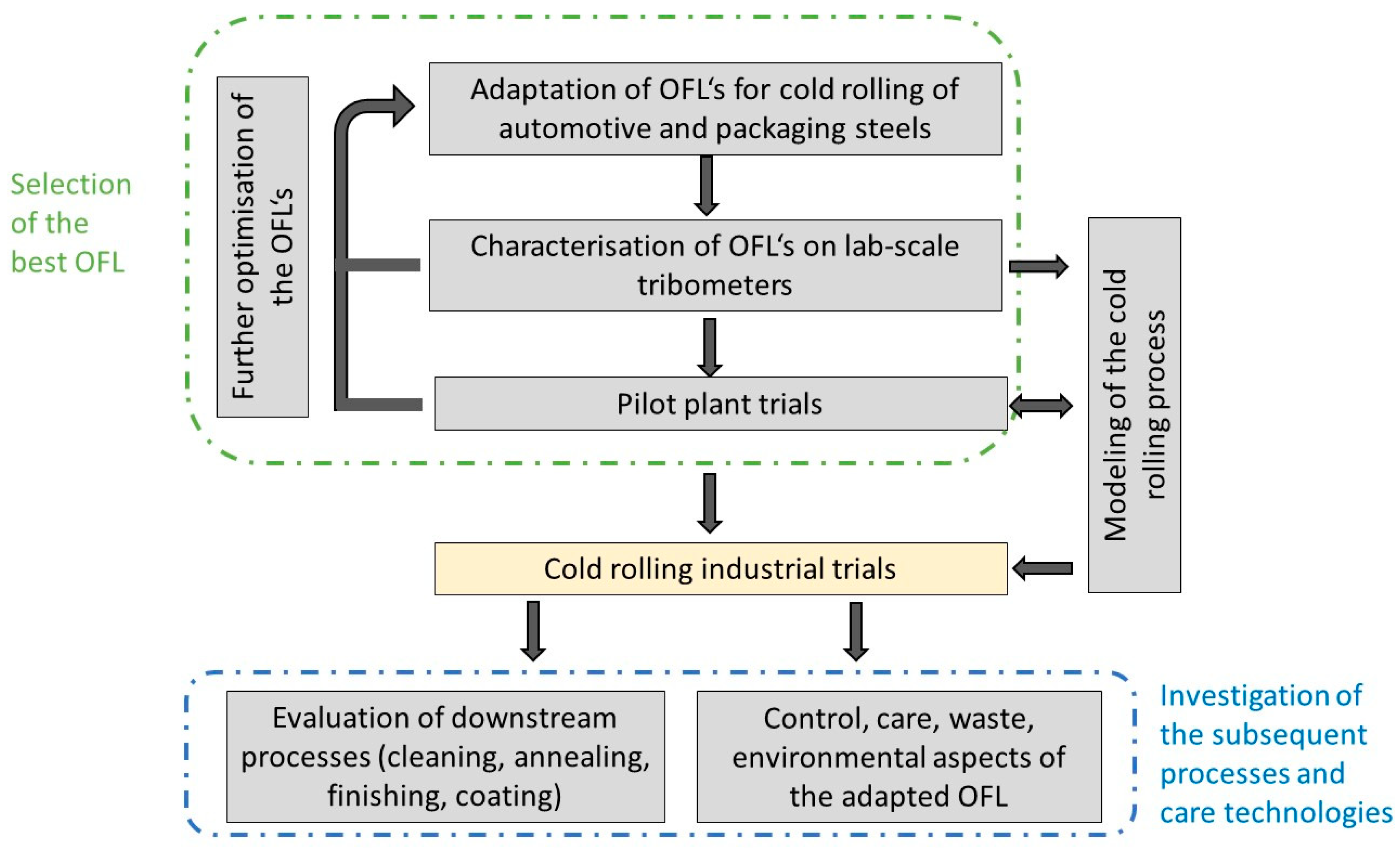

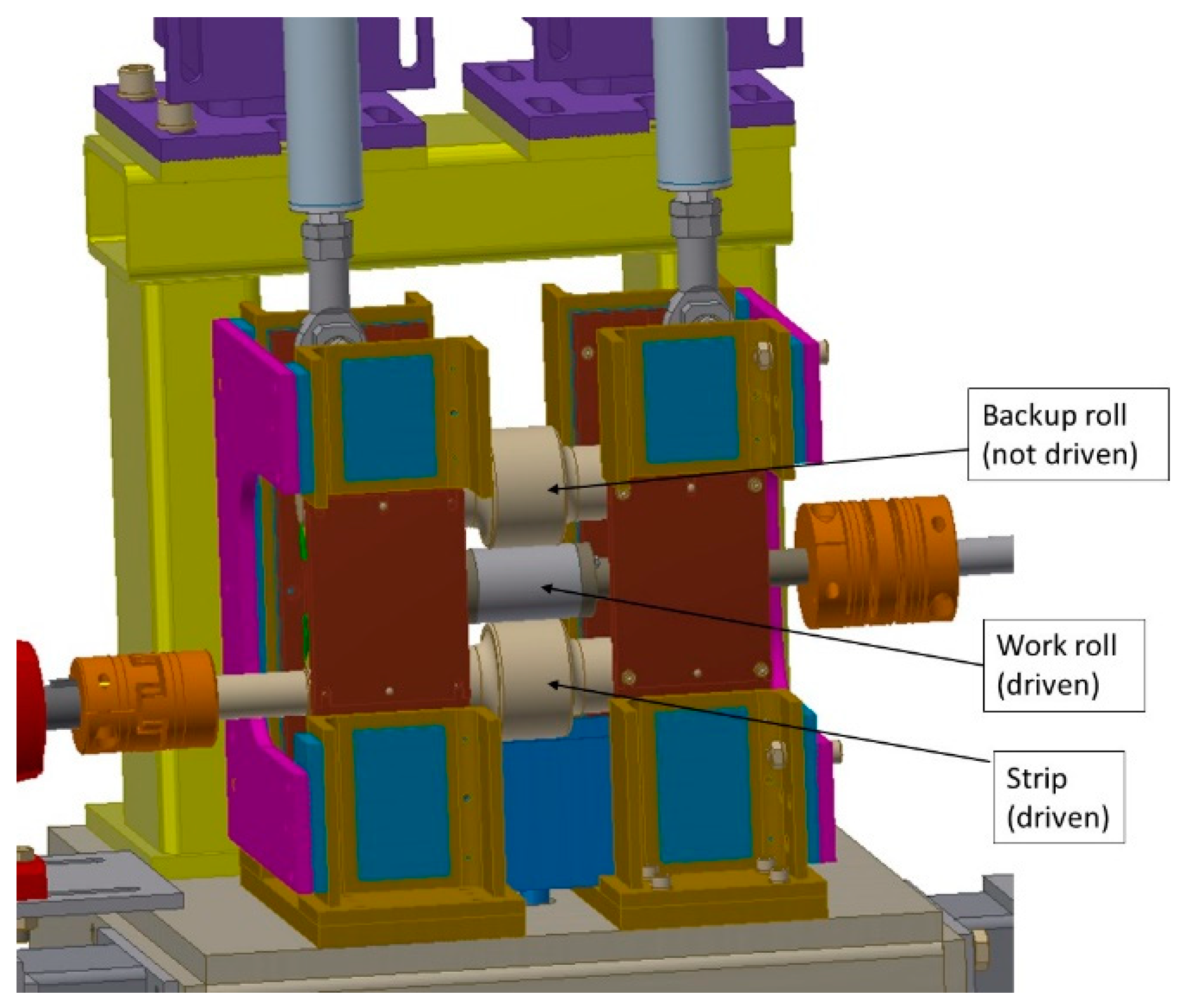
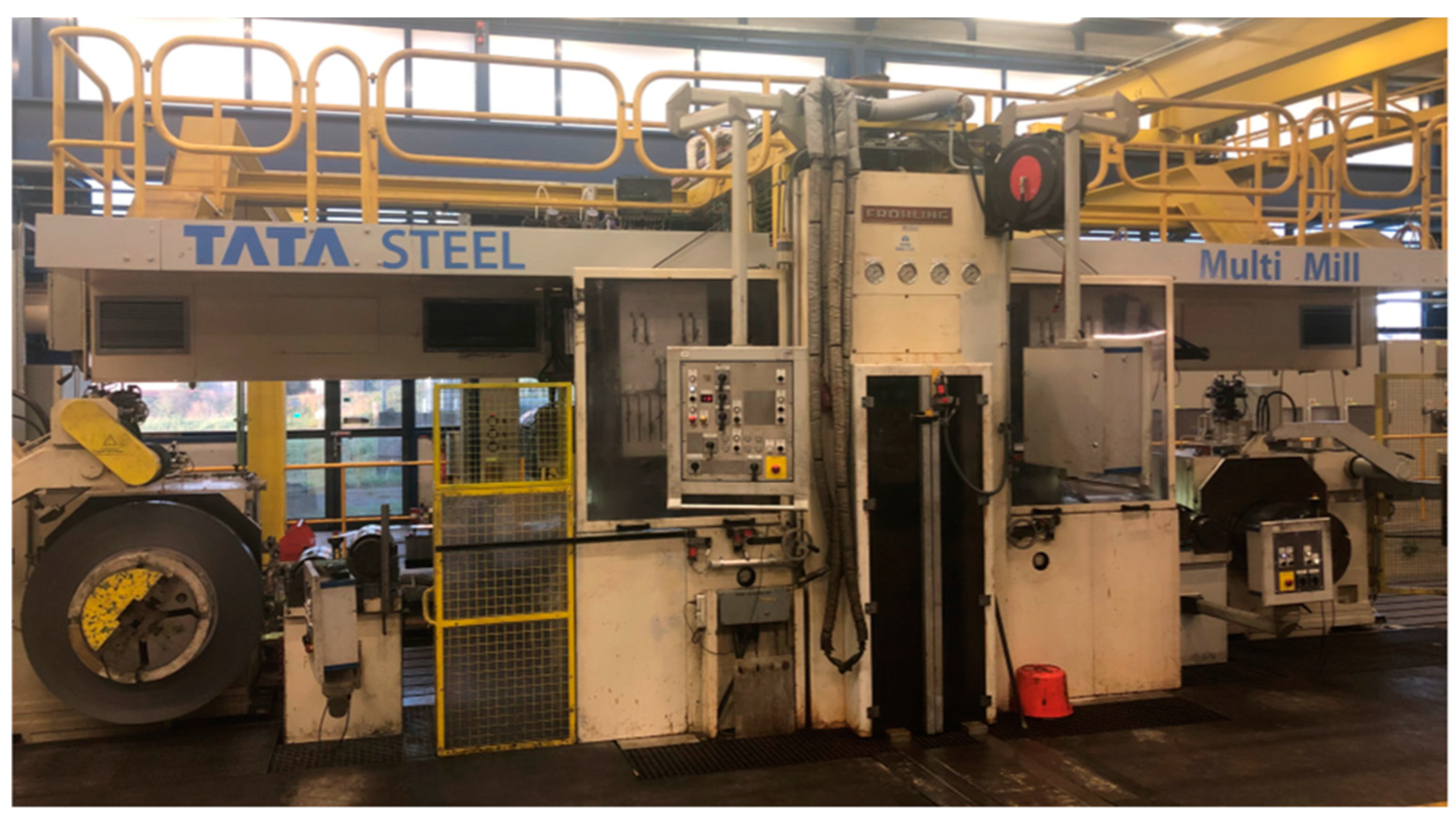
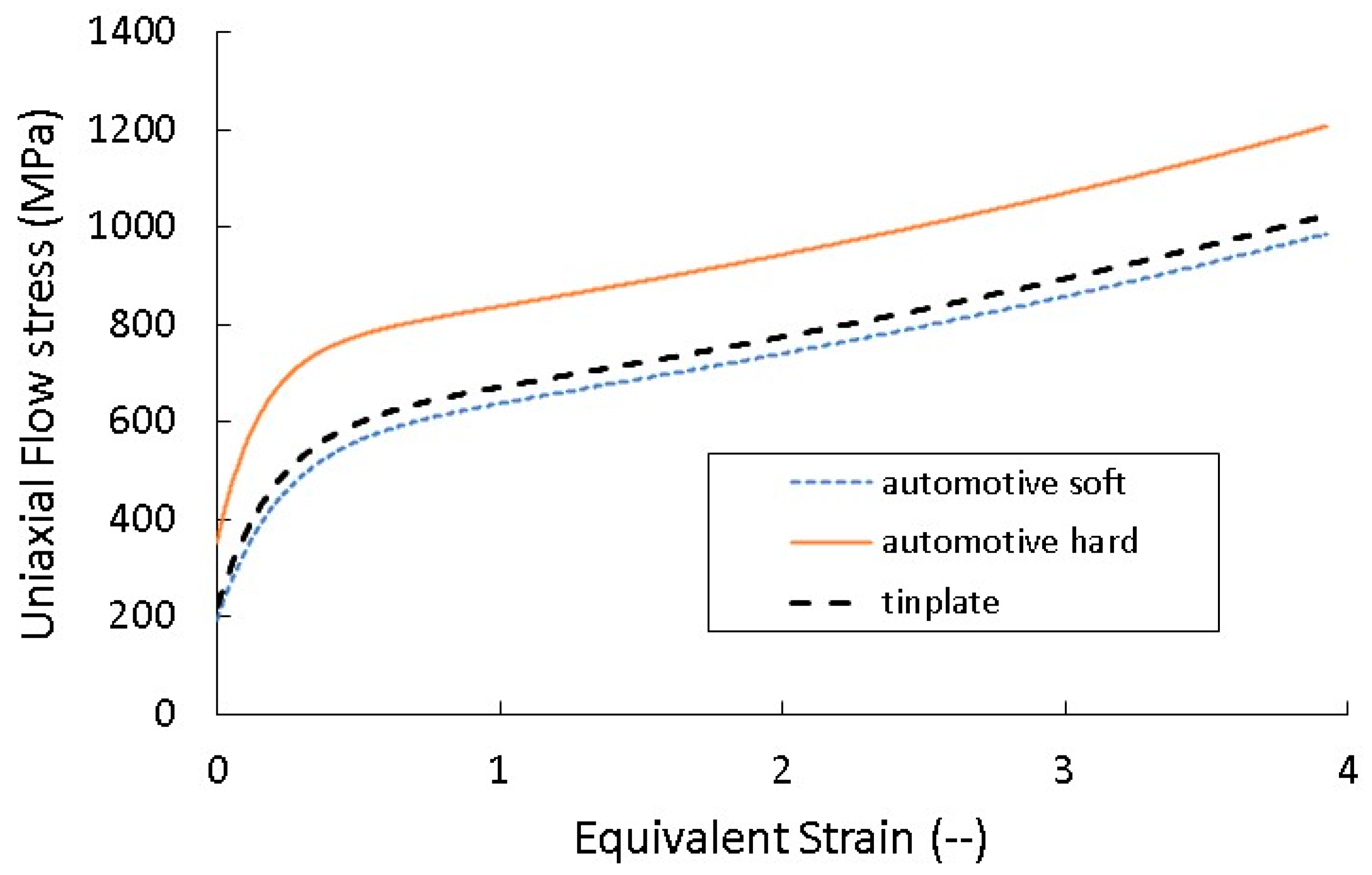
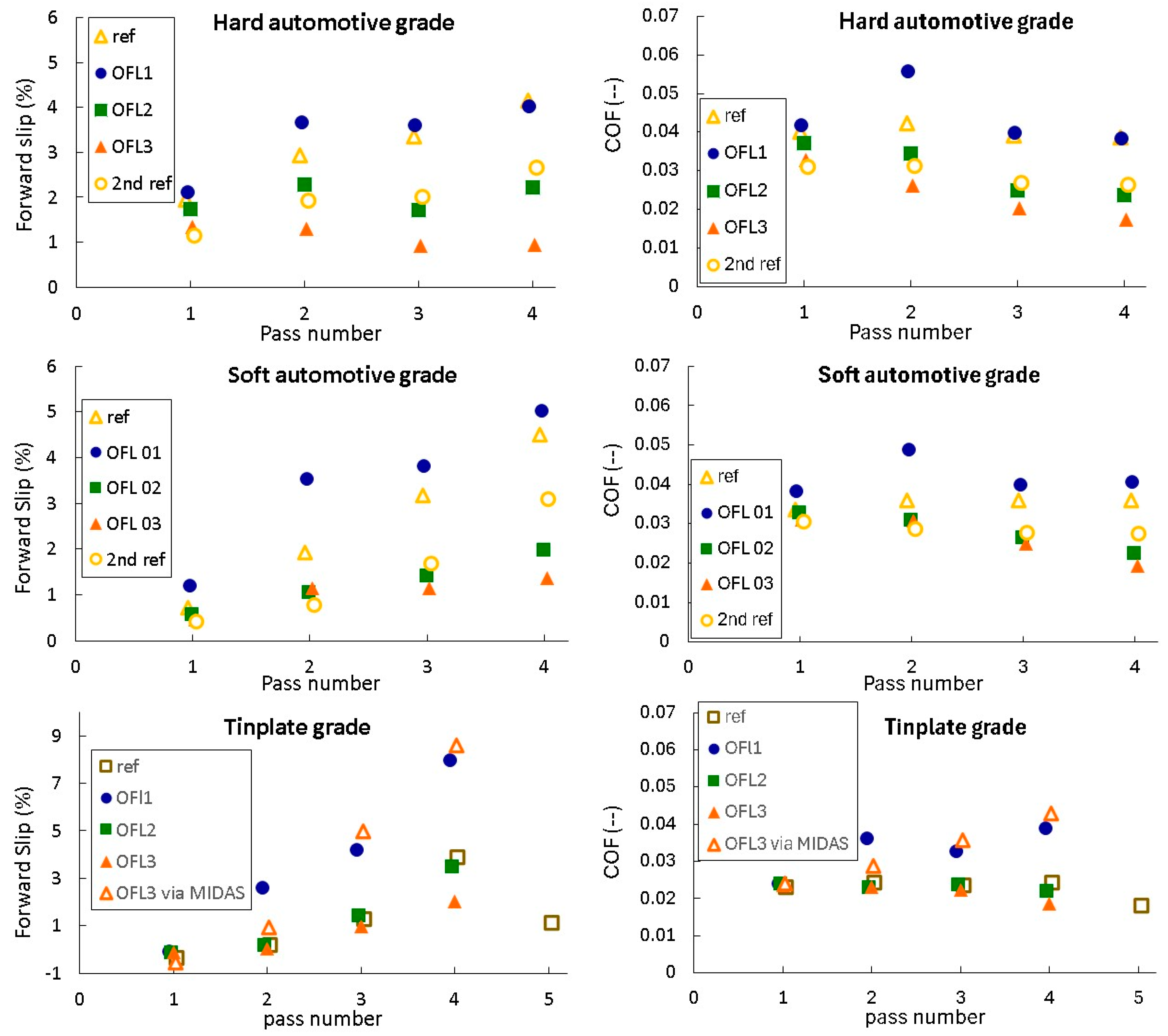
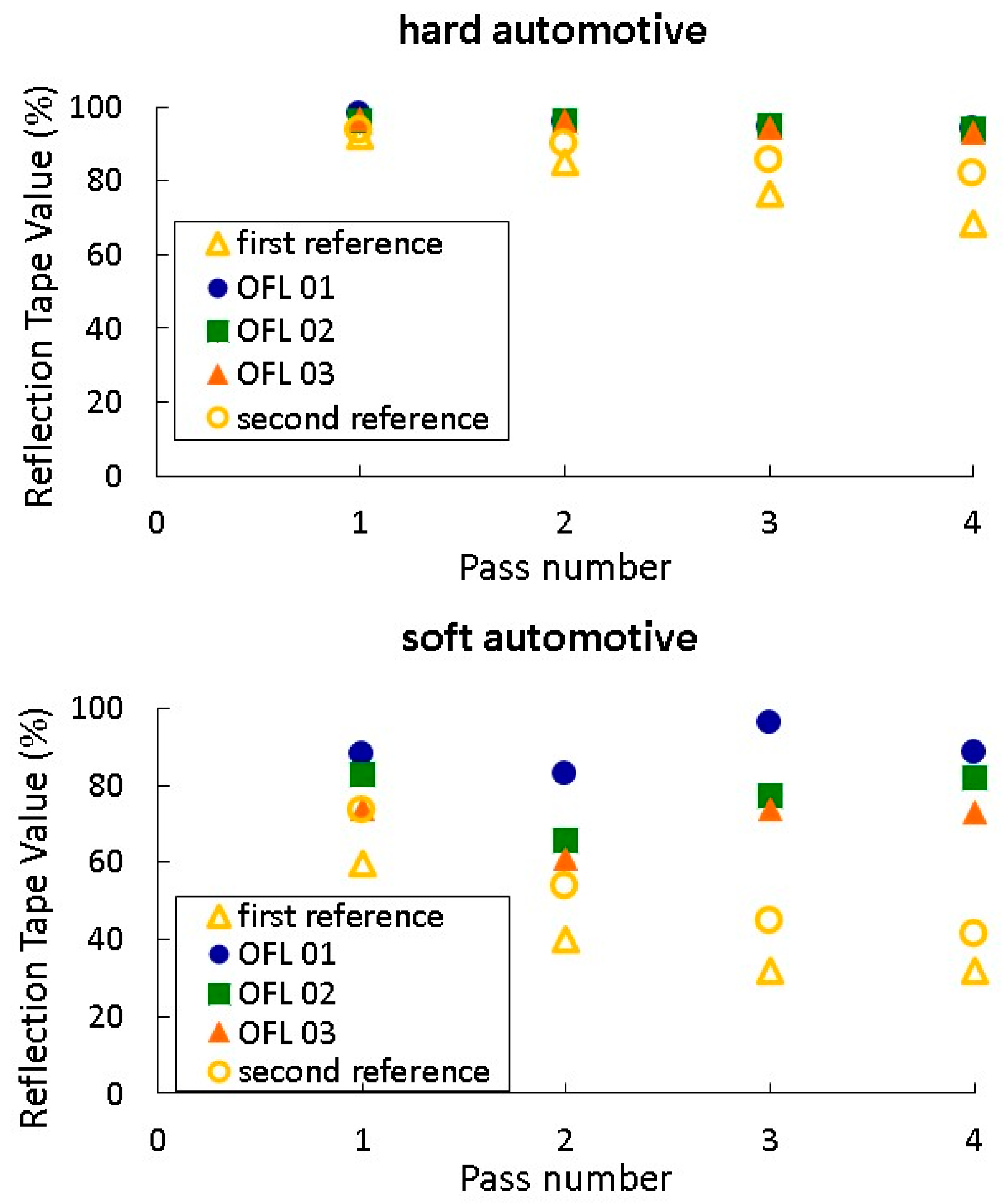


| Soft Automotive Grade | Hard Automotive Grade | Tinplate | |||||||
|---|---|---|---|---|---|---|---|---|---|
| Pass nr. | (mm) | (mm) | (m/s) | (mm) | (mm) | (m/s) | (mm) | (mm) | (m/s) |
| 1 | 2.50 | 1.80 | 4 | 1.80 | 1.40 | 4 | 2.00 | 1.35 | 4 |
| 2 | 1.80 | 1.28 | 7 | 1.40 | 1.10 | 7 | 1.35 | 0.85 | 7 |
| 3 | 1.28 | 0.89 | 10 | 1.10 | 0.85 | 10 | 0.85 | 0.52 | 10 |
| 4 | 0.89 | 0.65 | 11 | 0.85 | 0.65 | 11 | 0.52 | 0.33 | 11 |
| 5 | 0.33 | 0.23 | 12 | ||||||
| Soft Automotive | Hard Automotive | Tinplate | |||
|---|---|---|---|---|---|
| Coil Nr. | Coil Nr. | Coil Nr. | |||
| 1 | Run in the work rolls | 2 | Run in the work rolls | ||
| 3 | ref 1: O/W emulsion | 4 | ref 1: O/W emulsion | 5 | ref: DA loose emulsion |
| 6 | OFL 1 | 7 | OFL 1 | 8 | OFL 1 |
| 9 | OFL 2 | 10 | OFL 2 | 11 | OFL 2 |
| 12 | OFL 3 | 13 | OFL 3 | 14 | OFL 3 (recirculating) |
| 15 | ref 2: O/W emulsion | 16 | ref 2: O/W emulsion | 17 | OFL 3 (via MIDAS) |
Disclaimer/Publisher’s Note: The statements, opinions and data contained in all publications are solely those of the individual author(s) and contributor(s) and not of MDPI and/or the editor(s). MDPI and/or the editor(s) disclaim responsibility for any injury to people or property resulting from any ideas, methods, instructions or products referred to in the content. |
© 2025 by the authors. Licensee MDPI, Basel, Switzerland. This article is an open access article distributed under the terms and conditions of the Creative Commons Attribution (CC BY) license (https://creativecommons.org/licenses/by/4.0/).
Share and Cite
Jacobs, L.; Rèche, D.; Bán, A.; Colla, V.; Toscanelli, O.; Raulf, M.; Schlupp, M.; Smeulders, B.; Cook, M.; Filemon, W. Development of Oil-Free Lubricants for Cold Rolling of Low-Carbon Steel. Processes 2025, 13, 1234. https://doi.org/10.3390/pr13041234
Jacobs L, Rèche D, Bán A, Colla V, Toscanelli O, Raulf M, Schlupp M, Smeulders B, Cook M, Filemon W. Development of Oil-Free Lubricants for Cold Rolling of Low-Carbon Steel. Processes. 2025; 13(4):1234. https://doi.org/10.3390/pr13041234
Chicago/Turabian StyleJacobs, Leon, Delphine Rèche, Andreas Bán, Valentina Colla, Orlando Toscanelli, Martin Raulf, Martin Schlupp, Bas Smeulders, Mike Cook, and Wim Filemon. 2025. "Development of Oil-Free Lubricants for Cold Rolling of Low-Carbon Steel" Processes 13, no. 4: 1234. https://doi.org/10.3390/pr13041234
APA StyleJacobs, L., Rèche, D., Bán, A., Colla, V., Toscanelli, O., Raulf, M., Schlupp, M., Smeulders, B., Cook, M., & Filemon, W. (2025). Development of Oil-Free Lubricants for Cold Rolling of Low-Carbon Steel. Processes, 13(4), 1234. https://doi.org/10.3390/pr13041234










